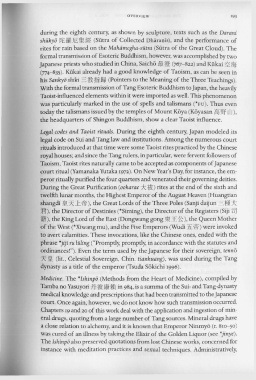Page 233 - The Encyclopedia of Taoism v1_A-L
P. 233
OVERV IEW 193
during the eighth century, as shown by sculpture, texts such as the Darani
shukyo wt:m~tlH~ (Sutra of Collected DharaQ.ls), and the performance of
rites for rain based on the Mahamegha-sutra (Sutra of the Great Cloud). The
formal transmission of Esoteric Buddhism, however, was accomplished by two
Japanese priests who studied in China, SaichO il*1!l (767- 822) and Kukai ~#lt
(774-835). Kiikai already had a good knowledge of Taoism, as can be seen in
his Sankyo shiki -= ~ t5' mm (Pointers to the Meaning of the Three Teachings).
With the formal transmission of Tang Esoteric Buddhism to Japan, the heavily
Taoist-influenced elements within it were imported as well. This phenomenon
was particularly marked in the use of spells and talismans (*FU). Thus even
today the talismans issued by the temples of Mount K6ya (K6yasan r§i!ff ill),
the headquarters of Shingon Buddhism, show a clear Taoist influence.
Legal codes and Taoist rituals. During the eighth century, Japan modeled its
legal code on Sui and Tang law and institutions. Among the numerous court
rituals introduced at that time were some Taoist rites practiced by the Chinese
royal houses; and since the Tang rulers, in particular, were fervent followers of
Taoism, Taoist rites naturally came to be accepted as components of Japanese
court ritual (Yamanaka Yutaka 1972). On New Year's Day, for instance, the em-
peror ritually purified the four quarters and venerated their governing deities.
During the Great Purification (ooharae jc~) rites at the end of the sixth and
twelfth lunar months, the Highest Emperor of the August Heaven (Huangtian
shangdi :£;R:...t ?in the Great Lords of the Three Poles (Sanji daijun -= ;@jc
tt), the Director of Destinies (*Siming), the Director of the Registers (Siji I§']
$'ff), the King Lord of the East (Dongwang gong *.3:. -0), the Queen Mother
of the West (*Xiwang mu), and the Five Emperors (Wudi Ji. *) were invoked
to avert calamities. These invocations, like the Chinese ones, ended with the
phrase *jiji ru lUling ("Promptly, promptly, in accordance with the statutes and
ordinances!"). Even the term used by the Japanese for their sovereign, tenn6
;R::£ (lit., Celestial Sovereign, Chin. tianhuang), was used during the Tang
dynasty as a title of the emperor (Tsuda S6kichi 1996).
Medicine. The *Ishinpo (Methods from the Heart of Medicine), compiled by
Tamba no Yasuyori ftlEZJi~ in 984, is a summa of the Sui- and Tang-dynasty
medical knowledge and prescriptions that had been transmitted to the Japanese
court. Once again, however, we do not know how such transmission occurred.
Chapters 19 and 20 of this work deal with the application and ingestion of min-
eral drugs, quoting from a large number of Tang sources. Mineral drugs have
a close relation to alchemy, and it is known that Emperor Ninmy6 (r. 810-50)
was cured of an illness by taking the Elixir of the Golden Liquor (see *jinye).
The Ishinpo also preserved quotations from lost Chinese works, concerned for
instance with meditation practices and sexual techniques. Administratively,

